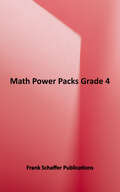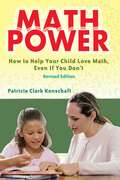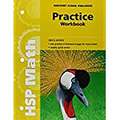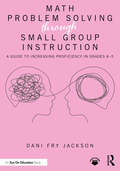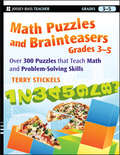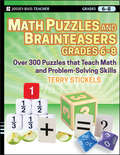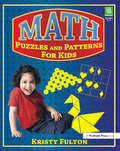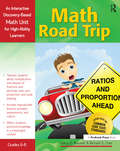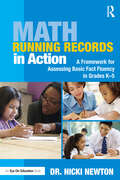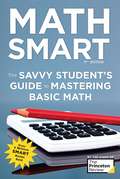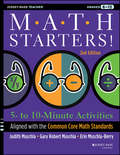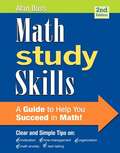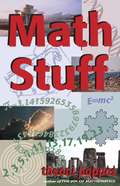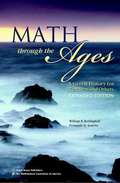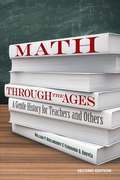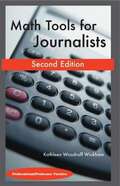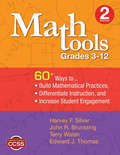- Table View
- List View
Math Power Packs Grade 4
by Frank Schaffer PublicationsGive students the learning power to move to the head of the class! This book features ten packets of reproducible activities that support state and NCTM standards, and cover the six essential strands of mathematics. Simply complete each packet's customizable cover sheet, reproduce the activity pages, and send them home with your students. The packets focus on numbers and counting, measurement, time and money, patterns and relations, algebra, shapes, data analysis and probability, and problem solving. It also includes a math vocabulary list, scoring rubric, calendar template, and tools to help build the home-school connection. Answer keys are also provided.
Math Power: How to Help Your Child Love Math, Even If You Don't (Dover Books on Mathematics)
by Patricia Clark KenschaftCritically acclaimed and commercially successful, this resource helps parents overcome their residual math anxiety and assists them in showing children how to enjoy the subject and excel at it. Packed with useful information and instruction, the book features proven teaching techniques, games, and other activities. Suitable for home schoolers and other parents of children from preschool to age 10. 2006 edition.
Math Problem Solving Through Small Group Instruction: A Guide to Increasing Proficiency in Grades K–5
by Dani Fry JacksonProblem solving in math is complex. When students struggle, it can be difficult to diagnose where the breakdown is happening. This book defines how reading comprehension, math computation, and self-efficacy impact students’ problem solving abilities and how you can support them in each area, with a particular focus on the use of small group instruction.Chapters break down the process of problem solving into an easy-to-follow progression, with lessons provided throughout. There is a step-by-step guide to help you analyze students' work, with tips on managing flexible small groups. Learning targets help show when students have mastered each step of a problem or flag difficulties you can assist with along the way. The author includes tasks for each grade level with an example response plan as a guide, alongside meaningful research informing small moves that can make big gains.Great for math educators of grades K–5, administrators, and math curriculum coordinators, this book will leave you feeling confident in identifying student behavior related to mathematical problem solving and addressing it with detailed ways to respond with exactly what your students need.
Math Puzzles and Brainteasers, Grades 3-5: Over 300 Puzzles That Teach Math and Problem-Solving Skills
by Terry StickelsNumber puzzles, spatial/visual puzzles, cryptograms, Sudoku, Kokuro, logic puzzles, and word games like Frame Games are all a great way to teach math and problem-solving skills to elementary and middle school students. In these two new collections, puzzle master Terry Stickels provides puzzles and brain games that range from simple to challenging and are organized by grade level and National Council of Teachers of Mathematics (NCTM) content areas. Each book offers over 300 brain games that will help students learn core math concepts and develop critical thinking skills. The books include a wide range of puzzle types and cover a variety of math topics, from fractions and geometry to probability and algebra.
Math Puzzles and Brainteasers, Grades 6-8: Over 300 Puzzles that Teach Math and Problem-Solving Skills
by Terry StickelsNumber puzzles, spatial/visual puzzles, cryptograms, Sudoku, Kokuro, logic puzzles, and word games like Frame Games are all a great way to teach math and problem-solving skills to elementary and middle school students. In these two new collections, puzzle master Terry Stickels provides puzzles and brain games that range from simple to challenging and are organized by grade level and National Council of Teachers of Mathematics (NCTM) content areas. Each book offers over 300 brain games that will help students learn core math concepts and develop critical thinking skills. The books include a wide range of puzzle types and cover a variety of math topics, from fractions and geometry to probability and algebra.
Math Puzzles and Patterns for Kids: Grades 2-4
by Kristy FultonMove beyond the norm in your math classroom and challenge students to think critically with Math Puzzles and Patterns for Kids. Exploring the hottest concept in puzzle solving—math logic puzzles—Math Puzzles and Patterns for Kids teaches students how to use reasoning to solve some of math's biggest conundrums: real-life patterns and puzzles such as Fibonacci's sequence, Sudoku puzzles, tangrams, Pascal's triangle, and magic squares. Students are taught the basic premises behind each challenging puzzle and are then asked to use the skills they have learned to solve multiple versions of each puzzle. Grades 2-4
Math Road Trip: An Interactive Discovery-Based Mathematics Units for High-Ability Learners (Grades 6-8)
by Richard Cote Darcy BlauveltIn Math Road Trip, students learn about the concepts of addition, subtraction, multiplication, and division of fractions and decimals, explore ratio and proportion, and investigate scale drawing and rate problems as they plan the ultimate vacation for their families. The Interactive Discovery-Based Units for High-Ability Learners, for grades 6-8, provides teachers with opportunities to use exciting and challenging units in their classrooms. These engaging curriculum units culminate in authentic performance situations that provide students with open-ended opportunities to demonstrate academic understanding. Each book in the series contains tiered lessons that teachers can easily modify to meet individual students' needs.Grades 6-8
Math Running Records in Action: A Framework for Assessing Basic Fact Fluency in Grades K-5
by Nicki NewtonIn this new book from popular consultant and bestselling author Dr. Nicki Newton, you’ll discover how to use Math Running Records to assess students’ basic fact fluency and increase student achievement. Like a GPS, Math Running Records pinpoint exactly where students are in their understanding of basic math facts and then outline the next steps toward comprehensive fluency. This practical book introduces a research-based framework to assess students’ thinking and move them toward becoming confident, proficient, flexible mathematicians with a robust sense of numbers. Topics include: Learning how often to administer Math Running Records and how to strategically introduce them into your existing curriculum; Analyzing, and interpreting Math Running Records for addition, subtraction, multiplication, and division; Using the data gathered from Math Running Records to implement evidence-based, research-driven instruction. Evaluating students’ speed, accuracy, flexibility, and efficiency to help them attain computational fluency; Each chapter offers a variety of charts and tools that you can use in the classroom immediately, and the strategies can easily be adapted for students at all levels of math fluency across grades K-8. Videos of sample running records are also available for download at https://guidedmath.wordpress.com/math-running-records-videos.
Math Smart, 3rd Edition: The Savvy Student's Guide to Mastering Basic Math
by Princeton ReviewNEVER GET CRUNCHED BY NUMBERS AGAIN. Even in a world where every cell phone is also a calculator, basic math competency is a must! In this book, you'll learn how to efficiently solve common problems and effortlessly perform foundational math operations like addition, subtraction, multiplication, and division. Once you've got that down, we'll go over how to handle the scary stuff—like exponents, square roots, geometry, and algebra.Our user-friendly techniques break complicated problems down into their basic parts, so that you don't waste your time memorizing dozens of long formulas and equations.THIS THIRD EDITION INCLUDES:· Back-to-basics reviews of numbers, fractions, ratios & proportions, exponents & roots, algebra, geometry, and probability & statistics· Comprehensive reviews for solving problems in common math topics· Targeted strategies to help you score higher on the quantitative sections of the SAT, ACT, GRE, and GMAT· Access to additional challenging drill questions online· Key math terms lists at the end of each chapter
Math Starters: 5- to 10-Minute Activities Aligned with the Common Core Math Standards, Grades 6-12
by Gary Robert Muschla Erin Muschla Judith A. MuschlaA revised edition of the bestselling activities guide for math teachers Now updated with new math activities for computers and mobile devices—and now organized by the Common Core State Standards—this book includes more than 650 ready-to-use math starter activities that get kids quickly focused and working as soon as they enter the classroom. Ideally suited for any math curriculum, these high-interest problems spark involvement in the day's lesson, help students build skills, and allow teachers to handle daily management tasks without wasting valuable instructional time. A newly updated edition of a bestselling title Ideal for math teachers in grades six through twelve Includes more than 650 ready-to-use starter problems
Math Study Skills
by Alan BassMath Study Skills outlines good study habits and provides students with study strategies and tips to improve in areas such as time management, organization, and test-taking skills. With a friendly and relatable voice, Alan Bass addresses the misgivings and challenges many students face in a math class, and offers techniques to improve their study skills, as well as opportunities to practice and assess these techniques. This math study skills workbook is short enough to be used as a supplement in a math course, but can also be used as a main text in a study skills class.
Math Stuff
by Theoni PappasWhether it's stuff in your kitchen or garden, stuff that powers your car or your body, stuff that helps you work, communicate or play, or stuff that you've never heard of you can bet that mathematics is there.MATH STUFF brings it all in the open in the Pappas style.Not many people think of mathematics as fascinating, exciting and invaluable. Yet Pappas writes about math ideas in such a way that conveys its often overlooked fascination, excitement, and worth. MATH STUFF deals with 38 topics in an non-threatening way that piques our curiosities. Open the book at random, and learn about such topics as: what a holyhedron is, how computers get stressed, how e-paper will work, how codes and numbers work with our bodies.By the end of this book you will think "Mathematics is the stuff that dreams are made of."
Math Through the Ages: A Gentle History for Teachers and Others
by William P. Berlinghoff Fernando Q. GouvêaWhere did maths come from? Who thought up all those algebra symbols, and why? What's the story behind ... negative numbers? ... the metric system? ... quadratic equations? ... sine and cosine? The 25 independent sketches in Math through the Ages answer these questions and many others in an informal, easygoing style that's accessible to teachers, students, and anyone who is curious about the history of mathematical ideas. Each sketch contains Questions and Projects to help you learn more about its topic and to see how its main ideas fit into the bigger picture of history. The 25 short stories are preceded by a 56-page bird's-eye overview of the entire panorama of mathematical history, a whirlwind tour of the most important people, events, and trends that shaped the mathematics we know today. Reading suggestions after each sketch provide starting points for readers who want to pursue a topic further.
Math Through the Ages: A Gentle History for Teachers and Others (Dover Books on Mathematics)
by William P. Berlinghoff Fernando Q. Gouvea"This is a beautiful, important book, a pleasure to read, in which the history recounted truly illuminates the mathematical ideas, and the ideas themselves are superbly explained; a wonderful accomplishment." — Barry Mazur, Harvard University"Math Through the Ages is a treasure, one of the best history of math books at its level ever written. Somehow, it manages to stay true to a surprisingly sophisticated story, while respecting the needs of its audience. Its overview of the subject captures most of what one needs to know, and the 30 sketches are small gems of exposition that stimulate further exploration." — Glen Van Brummelen, Quest University Designed for students just beginning their study of the discipline, this concise introductory history of mathematics is supplemented by brief but in-depth sketches of the more important individual topics. Covering such subjects as algebra symbols, negative numbers, the metric system, quadratic equations, and much more, this widely adopted work invites and encourages further study of mathematics.
Math Tools For Journalists: Professor/Professional Version
by Kathleen Woodruff WickhamCovers common math concepts such as percentages, statistics, business math, property taxes, polls/surveys, probability, and stocks and bonds.
Math Tools, Grades 3–12: 60+ Ways to Build Mathematical Practices, Differentiate Instruction, and Increase Student Engagement
by Edward J. Thomas John R. Brunsting Harvey F. Silver Terry WalshTeach to the Common Core, differentiate instruction, and keep students engaged—all at the same time! With new Common Core–aligned tools and strategies, this second edition of a bestseller is an all-in-one math classroom management resource. Covering everything from lesson design to math-specific learning styles, the book's 60+ tools will enable you to: <p><p> Work in smarter, more efficient ways with all of your students, no matter the class size or make up <p> Create standards-based lesson plans, tests, and formative assessments <p> Reach every learner regardless of understanding level or learning style <p> Integrate technology into class time for more engaging math lessons
Math Trailblazers: Grade 4 Student Guide
by Kathleen R. Anderson Anne Roby Lindy M. Chambers-BoucherNIMAC-sourced textbook
